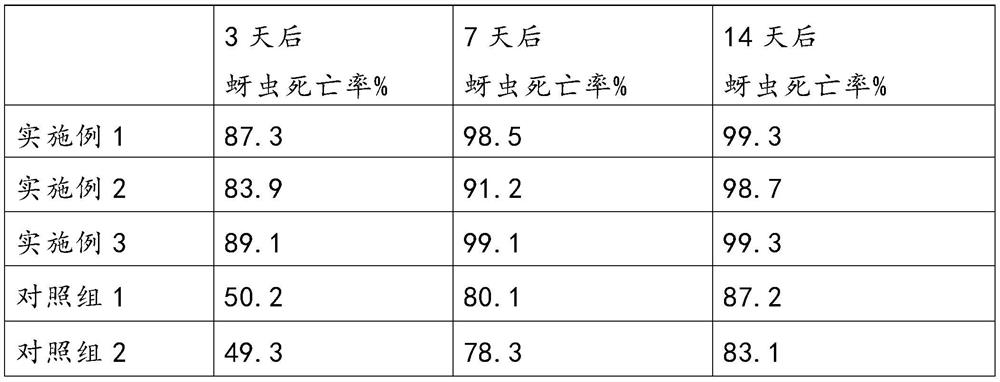Microbial insecticide for preventing and controlling aphids and preparation method of microbial insecticide
A technology for microbial insecticides and aphids, which is applied in the field of pest biological control, can solve problems such as loss, environmental pollution, and shortages, and achieve the effect of improving efficiency.
- Summary
- Abstract
- Description
- Claims
- Application Information
AI Technical Summary
Problems solved by technology
Method used
Image
Examples
Embodiment 1
[0016] A kind of microbial insecticide for preventing and treating aphids, microbial insecticide is obtained by solid activation culture of strains, bacterial strains include: 25% of Neoaphididae mold, 15% of Acinetobacter baumannii, 18% of Bacillus thuringiensis, Bacillus amyloliquefaciens 16%, Bacillus subtilis 14%, Serratia 12%.
[0017] The microbial insecticide for controlling aphids of the present invention is prepared according to the following method:
[0018] (1) Introduce P. neophidii and Acinetobacter baumannii into the liquid seed activation medium for activation, and then insert 6% of the inoculum into the expansion medium for primary culture. The concentration obtained from the cultivation is (1-4)×10 8 CFU / ml, and then the bacterial solution obtained from the primary culture was inserted into another expansion medium with an inoculation amount of 7% for secondary culture to obtain a concentration of (5-10)×10 9 CFU / ml;
[0019] (2) Insert Bacillus thuringiens...
Embodiment 2
[0025] A kind of microbial insecticide that is used for preventing and treating aphids, microbial insecticide is obtained by the solid activation culture of strain, bacterial strain comprises: 22% of new aphids Placiformis, 20% of Acinetobacter baumannii, 14% of Bacillus thuringiensis, Bacillus amyloliquefaciens 13%, Bacillus subtilis 15%, Serratia 16%.
[0026] The microbial insecticide for controlling aphids of the present invention is prepared according to the following method:
[0027](1) Introduce P. neoaphidii and Acinetobacter baumannii into the liquid seed activation medium for activation, and then insert 8% of the inoculum into the expansion medium for primary culture. The concentration obtained from the cultivation is (1-4)×10 8 CFU / ml, and then the bacterial solution obtained from the primary culture was inserted into another expansion medium with a 5% inoculation amount for secondary culture to obtain a concentration of (5-10)×10 9 CFU / ml;
[0028] (2) Insert Ba...
Embodiment 3
[0034] A kind of microbial insecticide that is used for preventing and treating aphids, microbial insecticide is obtained by the bacterial strain solid activation culture, and bacterial strain comprises: 28% of new aphidia mold, 17% of Acinetobacter baumannii, 12% of Bacillus thuringiensis, Bacillus amyloliquefaciens 17%, Bacillus subtilis 10%, Serratia 16%.
[0035] The microbial insecticide for controlling aphids of the present invention is prepared according to the following method:
[0036] (1) Introduce P. neophidii and Acinetobacter baumannii into the liquid seed activation medium for activation, and then insert 5% of the inoculum into the expansion medium for primary culture. The concentration obtained from the cultivation is (1-4)×10 8 CFU / ml, and then the bacterial solution obtained from the primary culture was inserted into another expansion medium with an inoculation amount of 7% for secondary culture to obtain a concentration of (5-10)×10 9 CFU / ml;
[0037] (2) ...
PUM
 Login to View More
Login to View More Abstract
Description
Claims
Application Information
 Login to View More
Login to View More - R&D
- Intellectual Property
- Life Sciences
- Materials
- Tech Scout
- Unparalleled Data Quality
- Higher Quality Content
- 60% Fewer Hallucinations
Browse by: Latest US Patents, China's latest patents, Technical Efficacy Thesaurus, Application Domain, Technology Topic, Popular Technical Reports.
© 2025 PatSnap. All rights reserved.Legal|Privacy policy|Modern Slavery Act Transparency Statement|Sitemap|About US| Contact US: help@patsnap.com

